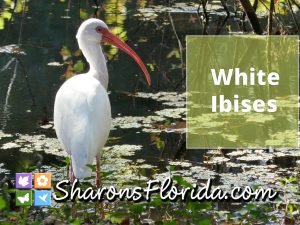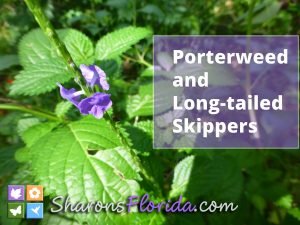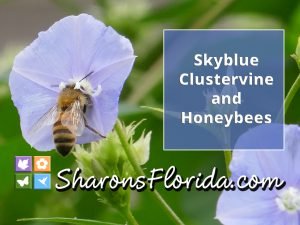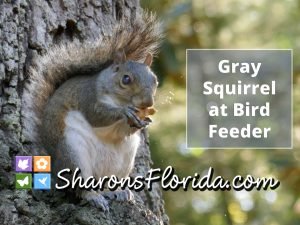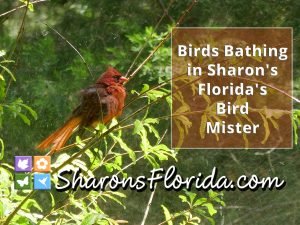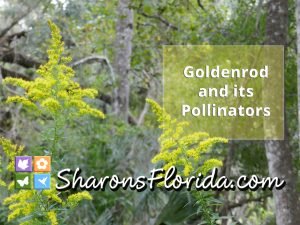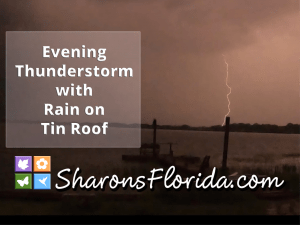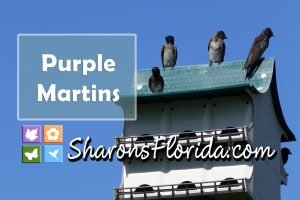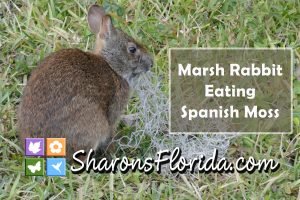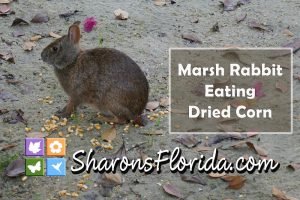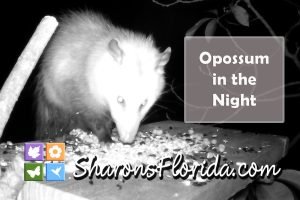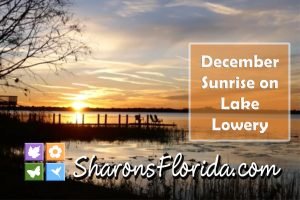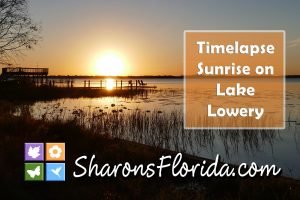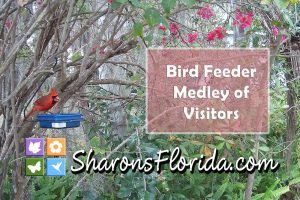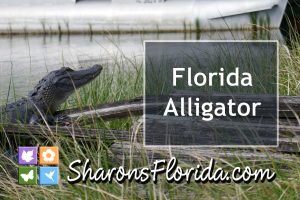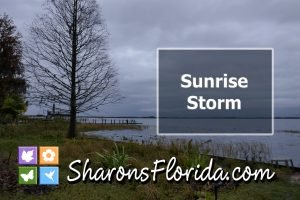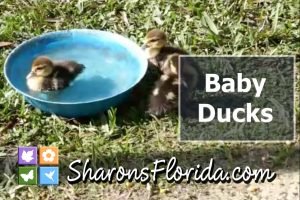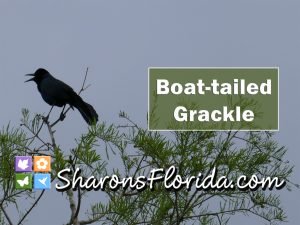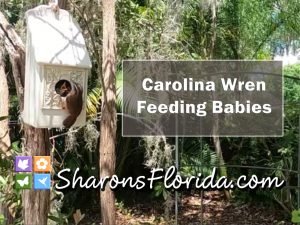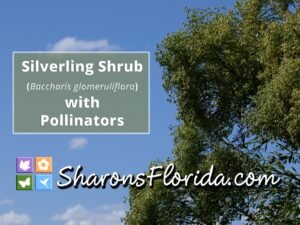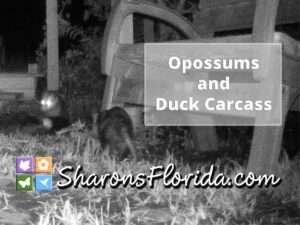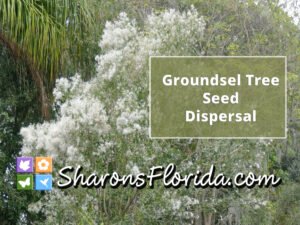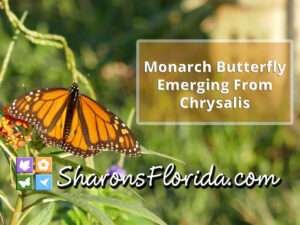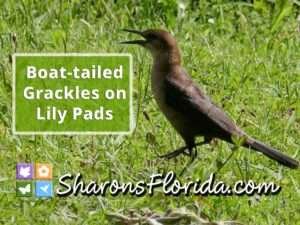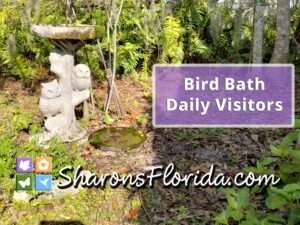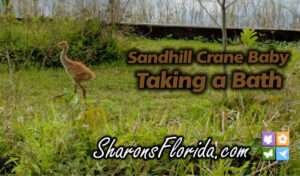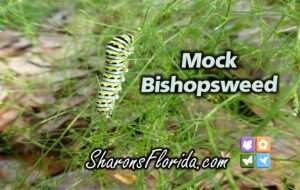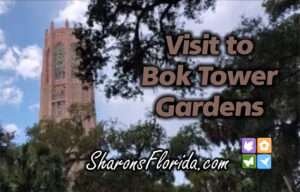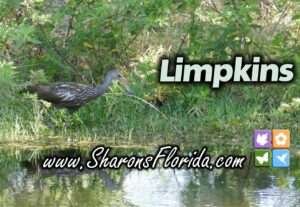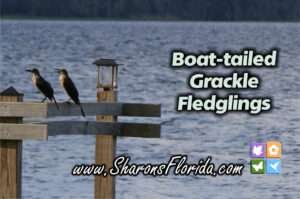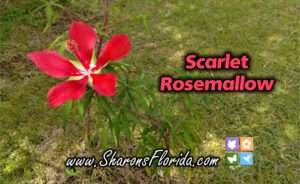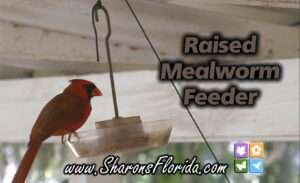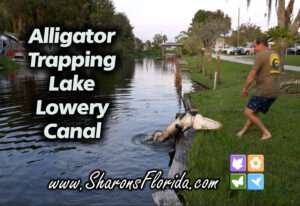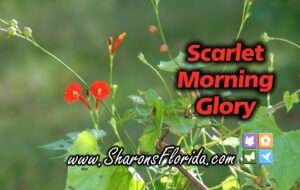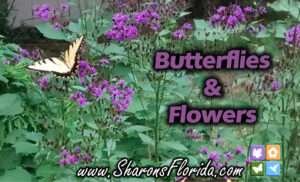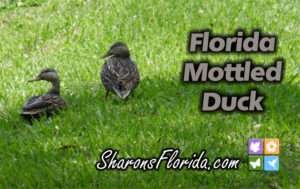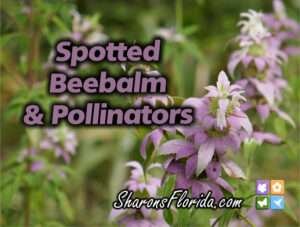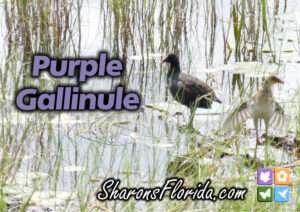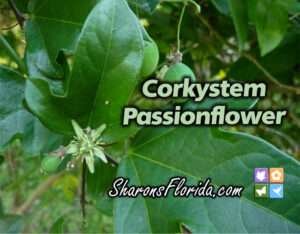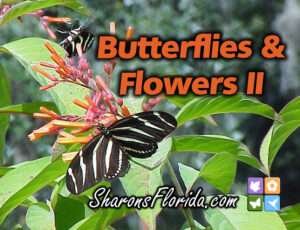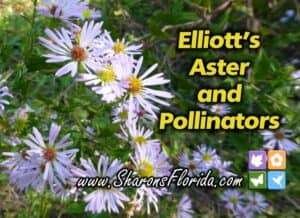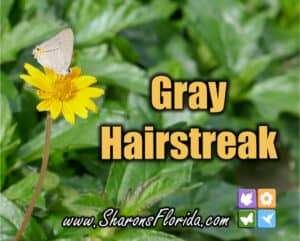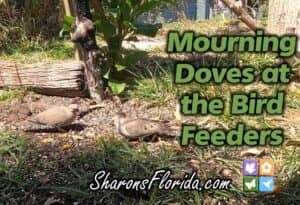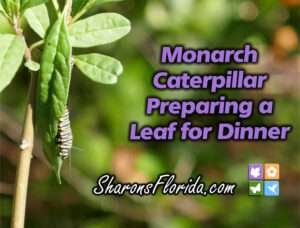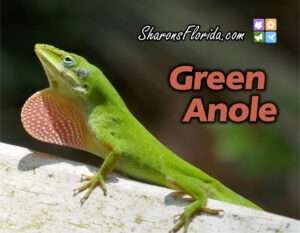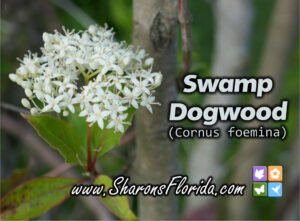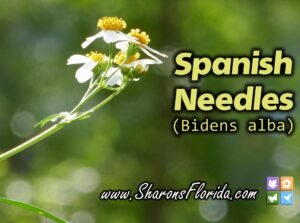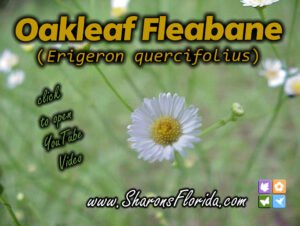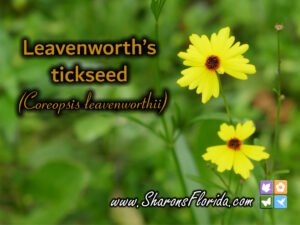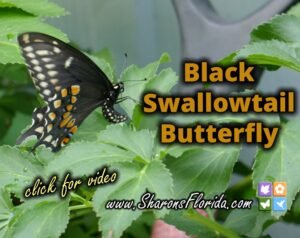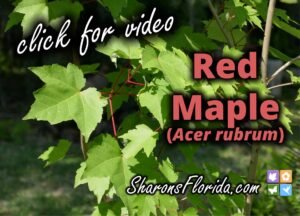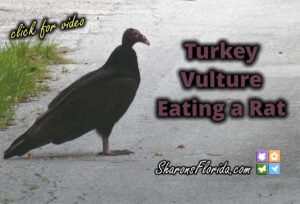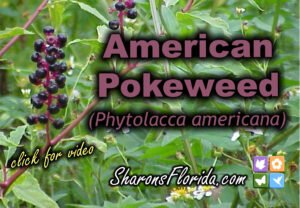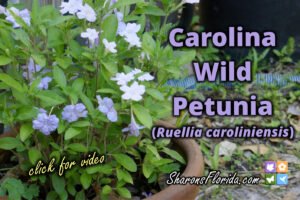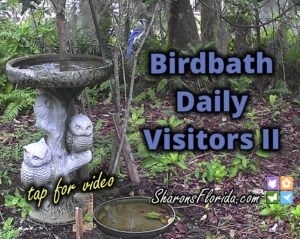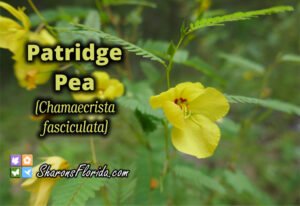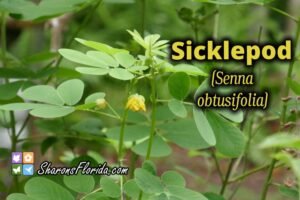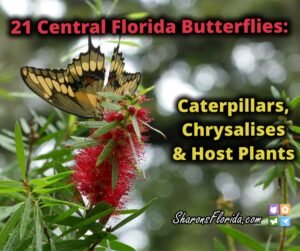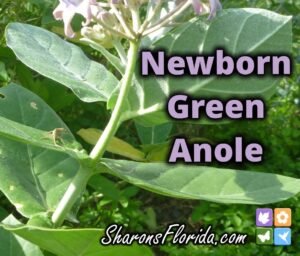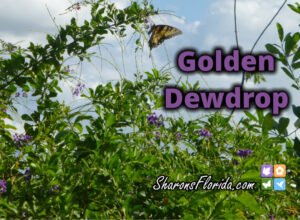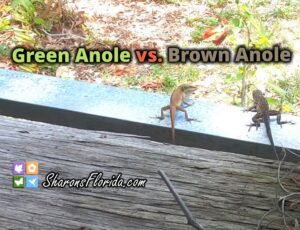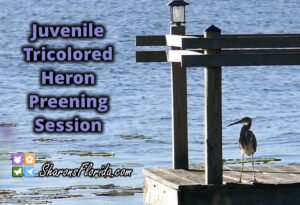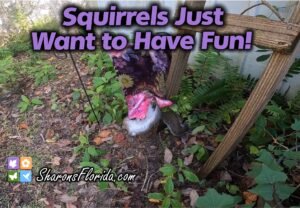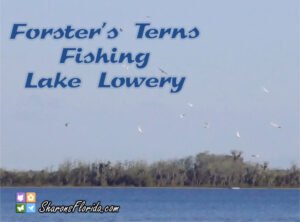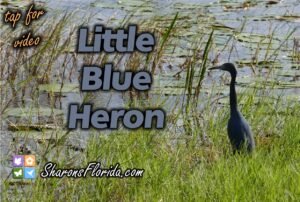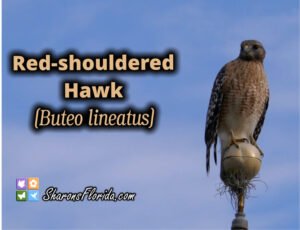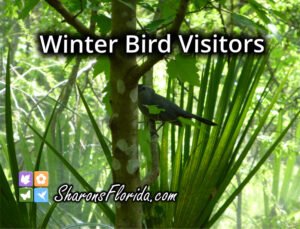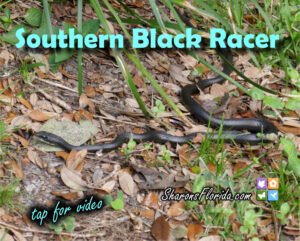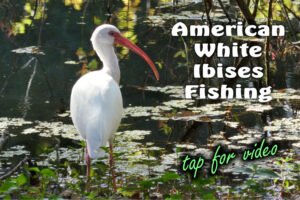Video Gallery
YouTube video of white ibises feeding and preening … set to relaxing music. Tap the photo to get there.
White ibises feeding & preening around a pond margin in Central Florida.
If you’d like to learn more about white ibises go to – https://sharonsflorida.com/wildlife/white-ibis/.
YouTube video of blue porterweed and long-tailed skipper butterflies … set to relaxing music. Tap the photo to get there.
Blue porterweed flowers being visited by long-tailed skippers, a zebra longwing, and a bumblebee or two. The blue porterweed in this video is not the Florida native one, but is Stachytarpheta cayennensis (nettleleaf velvetberry). The native, blue porterweed (Stachytarpheta jamaicensis), looks very similar, but grows low and spreads out along the ground.
YouTube video of skyblue clustervine flowers being nectared upon by honeybees set to relaxing music – tap the photo to get there.
Honeybees visiting the bright blue flowers of a skyblue clustervine in Central Florida.
YouTube video of a gray squirrel eating sunflower seeds … set to relaxing music … tap the photo to go there.
The really awesome Stoke’s feeders are at Amazon – https://amzn.to/2oWnf4r. This is an affiliate link … I get a tiny commission if you purchase them through this link.
Gray squirrels live in hollowed tree trunks, commonly using recycled woodpecker cavities, as well as leaf nests made from fresh leaves. It is important to leave tree snags as well as yard waste available for their use. To learn more about Recycling Your Yard Waste check out my article at – https://sharonsflorida.com/landscaping-with-natives/recycle-your-yard-waste/.
YouTube video of Sharon’s Florida’s bird mister.
Watch some cardinals bathing, and preening, in the mist created by my bird mister.
YouTube video of a mother sandhill crane and her baby eating cracked corn at a bird feeder.
A YouTube video of a river otter (Lontra canadensis) that stopped at my pond for an overnight visit and I was lucky enough to watch him swim, play, hunt, and eat a fish … tap on the photo to go there.
The last several years, in mid-January, I get a one day visit from what I believe is the same otter. Last year I didn’t have the chance to video him, but this year I was lucky enough to watch him catch a fish and then swim to the other side of the pond, near the brush pile, and eat it.
I’m not sure where he came from or where he’s headed, but he stops for an overnight and then he’s gone. I do live in a large watershed, which is a chain of lakes and streams that are all interconnected and drain into an area, known as Peck Sink Watershed. Peck Sink is a sinkhole that drains directly into the Florida aquifer. The watershed includes about 11,000 acres so he has a very large habitat to explore and I just hope he stays out of harm’s way.
He’s cute, but ferocious if you’re a fish.
My YouTube video showing the pollinators that visit goldenrod flowers. When goldenrod is in bloom it is a hive of activity because there are so many pollinators that use its flowers for nectar and pollen.
These are the pollinators that visited during this video.
European honey bee (Apis mellifera)
Red-banded Hairstreak (Calycopis cecrops)
Potter Wasp yellow on tail (Eumenes fraternus)
Solitary Potter Wasp (Monobia quadridens)
Tiphiid Wasp (Myzinum dubiosum)
Delta Flower Scarab Beetle (Trigonpeltastes delta)
My YouTube video Evening Thunderstorm with Rain on Tin Roof. Listen to the sounds of light rain on a tin roof during this evening thunderstorm in Central Florida.
Purple martins enjoying their lives at the lake. Check out these lovely little birds chattering, singing, and feeding their babies at the lake. Thanks to my neighbors Chris & Ralph for providing such a lovely purple martin house.
My YouTube video showing a marsh rabbit munching on Spanish moss.
Another marsh rabbit video. This time he’s munching on dried corn.
A beautiful opossum munching on sunflower seeds. I caught this nocturnal beauty on my CamPark trail camera.
If you purchase the trail cam through the above link I will receive a small commission as an Amazon Associate.
This is a very mellow video of a sunrise on the coldest day for Central Florida in 2020. It has a very quiet, native, soundtrack with some birds and ducks vocalizing and a squirrel barking at something. Enjoy the sounds of the waking lake inhabitants as the warming sun rises over the tree line.
A time-lapse video of a lake sunrise on December 27, 2020 which happened to be an extremely cold morning for Florida.
Shot with a GoPro Hero 8 set for timelapse.
If you purchase one through this link I will receive a very small commission as an Amazon Associate AND I sincerely appreciate the support.
There was a wide array of visitors at my trail cam today including goldfinches, Carolina wrens,
catbirds, mourning doves, cardinals, rats, squirrels, and tufted titmice.
See who stopped by!
I caught these bird feeder visitors on my CamPark trail camera.
Video clips of several small baby gators sunning on my dock, swimming in the lake, and hanging out underwater.
If you purchase one through this link I will receive a very small commission as an Amazon Associate AND I sincerely appreciate the support.
Very odd, gray and gloomy, storm at sunrise with wind, thunder, and sheets of rain.
By the end of the clip, we are welcomed with the morning songbird chorus.
A mother Muscovy duck came onto the property this morning with a large flock of babies.
Boat-tailed grackles are busy, loud, birds, and can be very entertaining to have visiting your green space.
There is an unusual leucistic (white patches caused by pigment loss) bird courting a female in the last two segments. He has some brilliant white wing feathers that can be seen when he is posturing to the female.
A pair of Carolina wrens chose to nest in my ceramic bird house. Once I realized they were raising a brood I supplemented their food by placing a saucer of mealworms on my patio which the adult birds took full advantage of. One of the most popular foods for the babies ended up being Cuban anole lizards. Many times a parent would just show up with a wriggling lizard tail. No wonder they grew so big and strong.
Shot with a GoPro Hero 8. If you purchase through my Amazon Associate link I’ll receive a small commission which I deeply appreciate.
A video of bumblebees visiting flowers in Central Florida.
A Northern flicker made a nest in a dead palm tree. Here’s a video of the mom and baby.
A video of our experience with Hurricane Ian 2022.
The silverling shrub (Baccharis glomeruliflora) is native to Florida coastal and riparian areas.
It grows to about 12 feet in height.
It likes moist to wet sites. The leaves are evergreen. The greenish yellow flowers attract a wide variety of pollinators such as honeybees, leafcutter bees, lovebugs, small wasps, small butterflies like hairstreaks, bee flies, and flower flies. When it is in bloom it is usually covered with pollinators.
It is a good candidate to help with soil erosion problems along lake fronts and river banks because it grows well in coastal areas and can withstand a good amount of wind and moist soil.
It is multi-trunked and has evergreen leaves so both of these traits makes it a good privacy plant candidate.
We set up the trail cam to solve the mystery of the missing duck carcass.
A few weeks previously we found a dead duck on the path, presumably of natural causes, and decided we’d wait until the next day to put it in the garbage bin. My husband and I forgot about it and a few days later we realized that the duck has disappeared and neither of us had dispatched it. So a few days ago a delivery driver ran over a duck on the street and we brought it to the back path to see what animal, or animals, would come and eat it.
We were surprised to see our beloved opossums going primal on it.
The previous duck carcass disappeared without the trace of a single feather yet after the opossums took a turn at a carcass there were feathers everywhere so the first one is still a mystery.
Here’s our experience with Hurricane Nicole 2022. Thankfully we were blessed and didn’t sustain and damage. To those that did you are in our thoughts and prayers.
This video shows how female zebra longwing butterflies emerge from their chrysalises already paired with a male. Sometimes it’s referred to as pupal rape, but I think pupal mating sounds much nicer.
The groundsel tree is also known as the sea myrtle and saltbush. The latin name is Baccharis halimifolia. It is an evergreen, native, shrub that grows to around fifteen feet in height. Its seeds are dispersed by the wind.
I was blessed to be able to record a monarch butterfly emerging from its chrysalis. It’s a beautiful, and strange, thing to see.
A group of three juvenile raccoons started coming into the yard this past week. I’ve tried to video them, but they are too skittish. The one in this video is the thinnest of the three and I suppose hungry enough to let me get close enough to record it. He is attracted to the corn I give the birds, so I prepared him a special treat of dried cat food and leftovers. Making wild animals reliant on humans for food is not a good idea because they lose their fear of us, often tear into stored foods, and waste bins, and if they become a nuisance are often trapped or killed. It’s best, but as you can see not always possible, to let them find their natural food sources.
Please remember that raccoons are wild animals and shouldn’t be handled. If you do get bitten, or scratched, only the killing and testing of the animal will potentially prevent you from undergoing a painful course of injections to ward off the infection. Therefore, keeping a safe distance and admiring from afar is safer for everyone.
The boat-tailed grackles forage in and under the lily pads for food. This particular time they were feeding their fledglings so I threw a handful of dried cat food on the pads and the parents fed all of their babies.
Check out the many visitors that come to my bird bath. This bird bath is set up with a dripper, and a lower water dish, and gets lots of action.
I’ve had a pair of juvenile opossums visiting for the last few weeks so I’ve been putting out cat food for them. I recorded their activities one night on my trail cam.
We have a new addition to our sandhill crane families. There are about three couples in our neighborhood and we are lucky enough to have one on our street. They bring him through the yard often with his dad doting on him and feeding him constantly. They sometimes eat the duck corn. I was lucky enough to have the GoPro set up and caught him taking a bath the other day.
My husband, who is into naming the animals, has dubbed him Frasier Crane.
It’s the end of March here in Central Florida and the tree swallows are starting to create huge flocks in preparation for heading back up north. In Central Florida tree swallows are winter residents only. They are feeding at dusk to take advantage of the midges and mosquitoes that are all around us at the lake.
Our lake provides a nice feeding area for them because of the swarms of non-biting midges. A midge’s life cycle occurs exclusively in the water and when they get to the adult stage they emerge from the water’s surface in huge numbers. It’s a nuisance for homeowner’s, but great for insect eating wildlife, and tree swallows are one of the many species that take advantage of the swarms.
The flocks of tree swallows usually include a few purple martins and other birds searching for a quick meal. The vocalizations in the background are mostly purple martins and boat-tailed grackles calling, but some of the tree swallows can be heard clicking their beaks as they are catching insects.
Mock Bishopsweed (Ptilimnium capillaceaum) is a wispy little wildflower that is native to Florida and is a host plant for the Eastern black swallowtail butterfly.
This video shows the plant and some of the caterpillars.
My friend, Jen in Knoxville, let me know that Wawa had a promotional thing for Bok Tower Gardens to get in free so Mike and I took advantage of it and visited the gardens.
We walk out to the tower and show off some of the native plants along the way, and then in their nursery.
The Mama muscovy took her babies into the muddy area at the edge of the lake. The babies had a blast. Occasionally we here one cheeping super loudly, and it’s because they got stuck in the mud, so we put on our Wellies and go get them and put them back with their family. In one part of the video you can hear one cheeping really loudly … that’s what they sound like when they get stuck and their family moves off. They are really cute to watch.
This family of limpkins lives on my street and I am so blessed to get to observe them. Last month the pair had four babies and I got to see them when they were very young. Unfortunately only three made it to be juveniles, but that’s what happens in nature. I was lucky enough to get a video of the three juveniles with their mom, and they are so beautiful to watch.
Limpkins need healthy waterways with lots of mussels because that is their main food. I’m sorry, but I don’t know what type of mussels these are. Maybe one day I will gather some shells and ID them. I’m glad our water is clean enough to support such beautiful wildlife. I worry because we do have a lot of homeowners that use pesticides, herbicides and lots of Round-up on their properties and at the lake edge. I’m glad it is not killing things outright, but I can’t imagine it’s healthy for our lovely Lake Lowery.
Hopefully one day they will ban most of those horrible things that the average Joe is not educated enough to be spraying wherever they feel the need. Lakes have water plants!
Marsh fleabane (Pluchea odorata) is a wet to moist site native wildflower.
It’s a great pollinator plant and is super easy to grow. You can grow it from seed, or if you find plants you can transplant them into your green space.
It is a perennial that grows in part shade to full sun with moist to wet soils. It grows to a height of about 3 to 4 feet.
I have seeds for sale at my Ebay store here – Marsh Fleabane (Pluchea odorata) ✤ 100 Seeds.
If you enjoy my content please join my mailing list (in the upper header) you’ll get updates on seed sales, videos and articles when I post them.
Most of the fledglings are on their own by now, but every now and then you can see a mom feeding one of them. Once the entire flock arrives it’s hard to tell the difference, but the fledlings act like babies … curious, uncoordinated, and learning how to interact amongst the flock. I gave them a treat of dry cat food so they were especially excited. Many of them like to dip the food bit in the water dish, or carry it around displaying it, before they eat it.
They are quite entertaining to observe so I just set up the GoPro and let it record until they got every last speck of food.
This would be a good video for entertaining your cat, taking a nap, a quiet meditation, or just background music.
Scarlet hibiscus is a perennial, native, shrub that grows to a height of 10 feet.
It grows in moist to wet soils.
It dies back to the ground in late winter and reemerges in late spring.
The bright red flowers are a hummingbird favorite.
It is native to the following states: AL, AR, FL, GA, LA, MS, NC, SC, and VA.
You can purchase plants at Mailorder Natives.
I really enjoy being able to supply the birds with mealworms because I get up-close and personal with them. I thoroughly enjoy watching them, their behaviors, and them raising their young.
I used to have a dish of mealworms on a low porch table and then a stray cat began to catch and kill the birds. The last straw was when the cat caught a male cardinal. For some reason I have very few cardinals in my neighborhood (probably because of all the stray, and free roaming, cats) so my husband suggested I put it up high enough where the cats couldn’t get to them so this is what he came up with for me and my birds.
As I show in the video my mealworm feeder is raised and lowered with paracord. It’s attached to the post with a small cleat and I use thin paracord that runs up to a solid loop bracket on a carport rafter. The solid loop bracket I use is called a pad eye. Just make sure whatever you use is a closed loop so the cord can’t come out of the opening and have your feeder crash to the ground as you are raising and lowering it, or when the birds feed. I would think even a large cup hook would work as long as you closed it shut with a pair of plyers.
The container I use is the bottom portion of a hummingbird feeder.
This video contains foul language.
August 1st, 2023, we were visited by, Glenn and Cameron of Hungry Gator, alligator trappers who were acting on a permit to remove a nuisance gator from our canal. This gator had been acting aggressively towards our local dogs, ducks, chickens, and people. It had clearly lost his fear of humans.
Glenn and Cameron caught it with a treble hook and had the animal loaded up in their catch-cage for transport within about an hour after arriving!
Glen operates a farm that harvests alligator eggs, and our gator will be its newest resident.
Thanks Glenn and Cameron – nice work! Hungry Gator 813-239-4914
Noyau vine (Distimake dissectus) is a lovely white morning glory native to Florida. It’s common name used to be Alamo vine. Its botanical synonyms include Merremia dissecta, Convolvulus dissectus, Ipomoea dissecta, Ipomoea sinuata, and Operculina dissecta.
The white flowers are large and funnel shaped with rose colored throats.
Unlike most morning glories the flowers stay open throughout the day.
Check out my plant profile for noyau vine here.
Reports state that it is poisonous to livestock and supposedly deer resistant. If your pets like to chew on foliage in your garden then this isn’t a good plant for your green space.
I sell these seeds at my Ebay store. Add noyau vine to your inventory of native plants!
Scarlet morning glory (Ipomoea hederifolia) is a native vine that is an annual, but readily reseeds and will return year after year if seeds are left to drop near the parent plant.
It is a dainty vine that grows to about 12 to 15 feet. It can be trained to grow on a trellis or left to spread along the ground as a groundcover.
It is a favorite nectar plant of hummingbirds and yellow sulphur butterflies.
It is native to Florida, Georgia, Massachusetts, Mississippi, Vermont, and Virginia,
It grows in zones 5b to 10b.
I have scarlet morning glory seeds for sale here at my Ebay Store!
Please enjoy my compilation of some of my butterfly visitors to the flowers in my garden. Each one is captioned with the butterfly name and the flower name. I hope you enjoy it!
Don’t forget about my book Central Florida Butterflies and their Host Plants: A Complete List of Native Host Plants because it will give you a reference to Florida native butterfly host plants. If you purchase through this link I will make a small commission and I would really appreciate the support. Thank you.
The anhinga is a large water bird found in Florida year round. It is sometimes called the snakebird because when it is swimming, and fishing, the head and neck are the only visible portions of the bird and it looks like a snake swimming through the water. Another common name is the water turkey. They are sometimes confused with cormorants because the behavior and habitat is similar.
Anhingids feed primarily on fish. They will also prey on: amphibians (salamanders, frogs, newts), reptiles (snakes, baby alligators, turtles), and invertebrates (insects, leeches, mollusks, crayfish, shrimp).
I have not found any literature that says they throw up pellets, but my video certainly shows one doing just that. I have been finding pellets on my dock and thought it was the barred owls, but I believe it’s the anhinga.
Check out my article about Anhingas in my Wildlife section – click here
Mottled ducks are small, brown, ducks that are found in Florida year round. Unlike many other ducks they do not migrate.
The Florida mottled duck is found in marshes, wetlands, lakes, ponds, rivers, streams, and coastal brackish water.
Check out my wildlife profile about the Florida Mottled Duck in my Wildlife section – click here
Spotted beebalm (Monarda punctata) is a native wildflower that the pollinators love. Another common name is dotted horsemint.
It is found in pinelands and scrub. In the home landscape it grows in full sun to part shade with average to dry soils. It gets to about three feet tall and just about as wide. It is a perennial and will come back year after year and once established needs no maintenance. The flowers and leaves can be used for a delicious tea fresh or dried.
Purple gallinules are extremely colorful waterbirds. The females are duller in color overall and the juveniles are a cinnamon brown-buff color. The adult males shine with the most magnificent colors of all. Their lower bodies are a deep violet-purple with a green-bronze sheen on their upper bodies. Their bills are bright red with a yellow tip and a turquoise shield that covers their foreheads.
Check out my wildlife profile about the Purple Gallinule here.
Corkystem passionvine is a native perennial vine that grows in part shade to almost complete shade with dry to average soils.
It grows to about twenty feet in length and needs no maintenance once established. It attaches itself to its support, or nearby vegetation, by way of tendrils.
It is a favorite host plant for zebra longwing butterflies. Zebra longwings prefer shady areas of the garden where they can stay cooler as they will overheat in full sun so this vine is perfect for attracting them to your green space. Gulf fritillaries do use this plant for a host plant, but seem to prefer the purple passionvine probably because it loves full sun.
Check out my plant profile about the Corkystem Passionflower here.
It is October and the butterflies are very active here in Central Florida. Please enjoy the visitors I’ve had in my garden the last few weeks.
I apologize for the overexposed video of the barred sulphur. I tried a couple of programs to adjust the color and never could get it right, BUT I wanted for people to see it and be able to ID it in their gardens. It is a very small butterfly and often goes overlooked. In flight you can see the black bars on its wings. It is sometimes mistaken for a cabbage white.
Diversity in your plant choices will help you with your butterfly garden so try to grow as many species of native host plants as you can so you can attract a variety of butterflies to your green space. Number 1 Rule … don’t use pesticides … find alternative ways to deal with something you consider a pest! Number 2 Rule … plant host plants in as many places as possible. Number 3 Rule … don’t dispose of dead foliage too quickly in the spring because you may be inadvertently killing chrysalises. Number 4 Rule … take the time to enjoy your butterflies! 🙂
This video focuses on the Leafcutter Bee (Megachile brevis). Leafcutter bees are black and white. They are mostly dark with white hair bands across the abdomen. The basket of hair on their abdomens is very long. They have short, wide bodies. Their eyes are very large compared to the rest of their body. They have a large pair of incisors for cutting leaves and their antennae are short. They are about the size of a honeybee and visit many of the same flowers. The distinguishing feature is the leafcutter’s pollen is stored on their abdomens instead of their legs like honeybees.
Leafcutter bees, as with all solitary bees, are on the decline. Our native bees are being ravaged by herbicide and pesticide use and habitat loss. These adorable bees are such a treasure to our native habitats.
It is very easy to attract native solitary bees, such as leaf cutter bees, to your garden. First, and formost, is to not use pesticides and provide as many wildflowers as possible. The easiest way to provide natural nesting areas is to leave some wild places in your green space where branches and the stalks of plants can be used by the bees for raising their young. Leave areas of bare earth where they can make ground tunnels. Another way to help them is to provide them with bee houses.
You can check out my wildlife profile here – Leafcutter Bee.
It’s the day before Thanksgiving and my Elliott’s aster is blooming like crazy! I have had a wide array of pollinators visiting it each day.
Mature plants reach a height of about 5 feet.
It occurs naturally on pond margins, wet ditches, wetlands and low areas with constant moisture.
The purple blooms appear in the fall and early winter.
It can be grown from seed (I should have some soon), but instant gratification can be had by buying plants at your local native plant nursery.
Hairstreaks are tiny butterflies being less than an inch in size most often. According to the Fish & Wildlife Conservation Commission there are over 160 species of hairstreaks in the state of Florida. They can be hard to identify as they are flitting around the garden because some are very similar with only subtle differences. Not to mention they move around really fast and can be hard to get a good look at.
This video focuses on the gray hairstreak’s behavior and host plants. At the end is a list of native host plants in Central Florida.
This little butterfly is sassy and bossy and makes a honeybee get off of her flower. Too cute!
Our native mourning dove (Zenaida macroura) is a member of the Columbidae, or dove, family of birds.
Some other common names are the American mourning dove, the rain dove, turtle dove, Carolina pigeon and Carolina turtledove. Their name comes from their mournful cooing call.
They readily visit bird feeders and bird baths. They much prefer ground level bird baths and platform, or table, feeders. They will eat most bird food mixes as well as cracked corn and sunflower seeds. They are large and cumbersome so small bird feeders can be a challenge for them.
Mourning doves are found throughout the United States north into Canada and south into the Caribbean. They are native and protected under the Migratory Bird Treaty Act although many in Florida do not migrate. They are a favorite of hunters and many states allow regulated hunting of them.
Mourning doves eat a variety of vegetation including grass seeds and grains. During the breeding season they will consume insects and small snails in order to supply the chicks with as much protein as possible. They forage on the ground underneath bird feeders and a scattering of cracked corn or sunflower seeds makes them very happy.
The common name for this native, green flowered, orchid is waterspider false reinorchid and its Latin name is Habenaria repens. It is a terrestrial as well as an aquatic orchid. One thing that’s nice about living on the lake is I get to find these beauties all throughout my green space. They pop up along the edge of the road, the lake edge, next to the seawall, and even in the middle of the lawn. Knowing what to look for when they are immature can help you to identify them so they can be left to bloom. I’ll show you what the immature ones look like so you might find some of your own. The flowers emit an amazing vanilla fragrance at night which attracts their moth pollinators.
Be sure to watch for the moth’s extra long tongues!
These orchids occur naturally in wet areas, swamps, bogs, pond and lake margins from North Carolina south to Florida and west to Arkansas and Texas. They can also be found growing on mats of floating vegetation. It is the only native aquatic orchid in North America!
I have noticed moths with these things on their heads before and did not know what it was until I researched for this video. The funny knobs on their heads are called pollinea.
A pollinea is a mass of 2 to 8 knob like packets of pollen. In the flower structure the pollinia are located underneath the male anther cap and contain a sticky structure called the viscidium. The viscidium helps the pollinia stick to the moth’s head so it can transport the pollen to other flowers. Pollinia are found in two plant families the orchids and the milkweeds.
To learn more about the Habenaria orchid go to my plant profile.
In Central Florida we have three native Senna plants.
Senna ligustrina (privet wild sensitive plant), Senna marilandica (Maryland wild sensitive plant), and Senna obtusifolia (sicklepod).
Two non-natives that are very common in Florida landscapes, and nurseries, are Senna pendula var. glabrata (valamuerto) which used to be called Senna bahamensis (Bahama cassia), and Senna alata (candlestick plant).
Three of our native sulphur butterflies use them as host plants for their caterpillars. These butterflies are cloudless sulphur, orange barred sulphur and the sleepy orange butterfly.
Native plants are easy to grow so give them a try!
Here are some links to order seeds for some of the plants in this video:
Privet wild sensitive plant (Senna ligustrina) seeds for sale at my ebay store.
Sicklepod (Senna obtusifolia) seeds for sale at my ebay store.
Red salvia (Salvia coccinea) seeds
Scarlet morning glory (Ipomea hederifolia) seeds for sale at my ebay store.
Some monarch caterpillars go to a lot of trouble to prepare their leaves they are going to have for dinner. They cut partially through the leaf rib, where it attaches to the main stem, to make the leaf collapse downward to give them a hiding place to eat in peace and safety. Once the leaf collapses they have a leaf canopy to feed under to hide from predators. So if you see a caterpillar doing this strange behavior you will know they are getting ready for dinner.
Green anoles are graceful and deliberate in their movements with a calm and curious personality. They don’t usually act fearful of humans, but will avoid humans. They don’t instantly flee like brown anoles do, but rather gracefully move away to a safer distance. If they happen to be somewhere low enough to watch a person gardening or weeding they will go after insects that the person disturbs. They are smart and curious and wonderful to have in the garden. Not mention they are beautiful to look at.
They are under threat by pesticide use, habitat loss, feral cats, and the brown anole. Green anoles are not very common in Florida anymore.
Swamp dogwood (Cornus foemina) is a native shrub that grows to a height of about 25 feet and grows in wet to moist sites. It’s easy to identify using the Cornus test and it transplants very easily. It’s a good candidate for privacy screening, and provide flowers for the pollinators and fruit for the animals.
Swamp dogwood, Cornus foemina, is a deciduous shrub that is native to Central Florida.
The common name, swamp dogwood, can apply to different plants so always refer to the Latin name to purchase the correct plant.
I bought mine at The Natives nursery in Davenport. Please go to my Resources Page for their information and some other native nurseries to locate your own swamp dogwoods is you can’t find free transplants.
Spanish needles is a super easy native Florida wildflower to grow. The butterflies and bees love the flowers. It grows in just about any soil with just about any moisture levels.
Spanish needles (Bidens alba) is a perennial wildflower that grows to about 3 feet in height. It grows in full sun with average to dry soils.
Spanish needles (Bidens alba) flowers provide nectar for many of Florida’s pollinators such as bees, butterflies, beetles, and flies. Rabbit and deer eat the foliage, flowers, and buds. The bee above is a Southern carpenter bee.
The tender new growth, and flowers, are edible as well and can be added to salads or used as a potherb.
Spanish needles (Bidens alba) is propagated by growing from seeds, root cuttings, and transplants. The seeds have hooked awns which cling to animal fur so wildlife propagate this wildflower far and wide.
It transplants at any size. Remove flowers so the transplant can focus energy on recovery and growing new roots.
Oakleaf fleabane is a perennial wildflower that is native to Florida and much of the Southeast.
It grows to a height of about eighteen inches when it has flower stalks.
Its leaves start to get robust and appear in late winter with the blooms soon to follow.
Once the heat of early summer rolls around the plants begin to die back and go relatively unnoticed until early winter next year.
I let it grow when it comes up in the lawn and if it comes up in an area where I don’t want it I transplant it into areas where other flowers are growing so I have something blooming right away at the end of winter.
Leavenworth’s tickseed is a native, annual, wildflower. It is endemic to Florida and several counties in south Alabama. Endemic means it’s only found in those locations. Coreopsis is also our state flower!
It grows to a height of about 2-3 feet when in flower. It likes full sun with moist to wet soil.
I was blessed to wake up to hot air balloons gliding over the lake. It was beautiful!
The Eastern black swallowtail is native to Florida and most of the eastern United States. It is found as far north as Quebec and south to northern South America.
It’s a beautiful medium sized swallowtail that is mostly black with a shimmering blue decoration along the edge of the wings with spots of yellow and orange.
Check out my article – Gardening for the Black Swallowtail Butterfly for even more information.
The red maple is native to Florida and is a large deciduous tree, which means it will drop its leaves in the fall and regrow them in the spring. They reach a mature height of 60 to 80 feet. They like moist soils. They are dioecious which means male and female flowers are on separate trees.
Once you learn to ID the baby red maples you can start collecting your own red maple trees to use in your green space!
You might already have maples and want to try to make syrup. Check this pdf out – Producing Maple Syrup From Boxelder and Norway Maple Trees – [https://extension.usu.edu/forestry/files/publications/utah-forest-facts/043-producing-maple-syrup.pdf]
Learn about the four other maple trees that are native to Florida here at my article : Maple Trees Native to Florida by Sharon R. LaPlante
Buddhist sky burial for a rat. We use electronic rat traps for the problem rodents in the workshop because they are damaging expensive equipment. I don’t throw them in the trash, but rather put them out for the hawks and vultures to eat. PLEASE so not do this if you poison the rats because you will kill the birds in the process.
Check out my article about the Ecosystem Services That Birds Provide.
The vultures are the clean-up crews and are an important part of our Florida ecosystems.
American pokeweed (Phytolacca americana) is a large, perennial, shrub in the Phytolaccaceae or pokeweed family.
It has many common names including poke salad, poke sallet, pokeberry, inkberry, poke, pocan, coakum, Virginia poke, poke root, scoke, pigeon berry, garget, cancer jalep, and chui xu shang lu (in Chinese medicine).
I have pokeweed seeds for sale at my Ebay store – https://www.ebay.com/itm/261868451304
I have a plant profile on pokeweed here – https://sharonsflorida.com/plants-page/native-shrubs/pokeweed/
Yellowjackets are good pollinators, but when they are constantly stinging people and being a general nuisance they need to go.
We exposed a yellowjacket nest hiding amongst the ferns and thought we could easily remove it. Well it turned out more difficult than we thought. We tackled it using a shop-vac, ammonia, alcohol, dish soap spray, then Murphy’s oil soap spray, then fire, then water, and when all of those things failed we used a pyrethrin spray.
We tried so many things and finally resorted to using a pyrethrin spray because we were so tired of battling them. Pyrethrin spray is supposed to be made from a compound extracted from the chrysanthemum flower. Hopefully the spray I purchased truly is not a toxic poison.
We isolated the spray in that one area and did it at dusk when other pollinators weren’t flying around. I’m hoping it really is non-toxic like the label says.
The Carolina wild petunia is native to the eastern United States. It is found in just about every Florida county and west to Texas and north to Indiana. It is native to the following states: AL, AR, DC, DE, FL, GA, IL, IN, KY, LA, MD, MS, NC, NJ, OH, OK, PA, SC, TN, TX, VA, and WV.
Carolina wild petunia is a perennial wildflower that grows to a height of about two feet although some literature says it grows much higher I have not found that to be the case. It gets gorgeous purple flowers on it and it grows in just about any soil type and moisture conditions. It’s a tough little native plant!
I have photo slides in the video with links to help you locate native plants with the Florida Association of Native Nurseries, and a link to the Florida Invasive Plant Council if you would like to learn about the non-native invasive Mexican petunia.
I have juvenile songbirds right now and they are learning how to take baths. They are very curious about the water in the bird bath containers as well as the dripping water so they investigate it every day and are gradually learning what to do with it. The hot weather is extreme right now so the birds really hang around the water sources. The juvenile blue jays and boat-tailed grackles are especially enjoying it.
Their parents are leaving them to hang out at the birdbath while they are off looking for food. My birdbath is a bird playground at the moment! There are even juvenile squirrels visiting to play with the plants, sticks and get drinks. It’s adorable watching all of the wildlife be so curious with the water, plants, leaves, other birds, and all the new things they are learning about.
Providing a water source is the most important aspect of attracting wildlife to your green space.
Don’t watch it while driving or operating machinery because this video one has a 30 minute meditation soundtrack, and no narration, so it may put you to sleep. . 😉
Partridge pea is a native annual wildflower that grows to a height of about three feet and is an excellent addition to a Florida wildlife habitat or butterfly garden.
It grows in full sun to part shade with average to dry soils. The bumblebees love it and it also happens to be a butterfly host plant for the ceraunus blue, the cloudless sulphur, the little yellow, the sleepy orange, the gray hairstreak, and the Io moth.
The ripe seeds are a favorite of bobwhite quail, songbirds, and small mammals.
Sicklepod (Senna obtusifolia) is an annual, native, wildflower that grows to about three feet in height and just about as wide.
It grows in full sun to part shade with average moisture. I have found it growing in moist and extremely dry sites so it’s very adaptable to different growing conditions. It can be grown in rich soil or sandy soil.
It’s a host plant for the following butterflies – cloudless sulphur, orange barred sulphur, and the sleepy orange.
See what the caterpillars and chrysalises look like for these 21 central Florida butterflies. I’ve included a list of native host plants for each, and at least one photo of one of them. We many butterflies and this is not an all inclusive list of every central Florida butterfly … just 21 of them.
Come along with us and enjoy a relaxing kayak ride and a beautiful sunset.
Mike heads into two different canals and I do my best to ID the plants along the way … with still shots at the end of the video sections to show you what they look like close-up.
Lake Lowery is a small lake but full of so many wonderful things like birds, dragonflies, water lilies, beautiful sunrises and sunsets. We enjoy kayaking the most because it’s so quiet and peaceful.
This morning I just about stepped on this little guy. He was in the center of the walkway so I guess he had just hatched and fell from the rafter above. He was wet and cold and was an unhealthy gray color. I kept him warm by keeping him in my hand and intermittently putting him in a ray of sunlight and soon he began to dry off and his color changed to green.
He slept a lot as I walked around the yard looking for a place to release him. He would open his eyes occasionally and look up into mine and it melted my heart so I knew I had to find a special place for him to have his best chance at being the newest resident of my wildlife oasis.
The Latin name for the golden dewdrops in this video is Duranta erecta variety “Sapphire Showers”. At one time it was classified as a Florida native plant but most references still have conflicting views. However, the Atlas of Florida Plants Institute for Systemic Botany claims it as non-native. Regardless it’s a great shrub for a Florida garden.
It is a perennial shrub that can reach a mature height of 15 to 18 feet and just about as wide. It is an amazing flowering shrub for pollinators.
In the home landscape it needs plenty of room to get to its full potential size of fifteen feet. It prefers full sun. It does best in full sun for overall flowering and the health of the plant. Being in full sun will keep it from getting leggy and it will flower much better and continuously. Deadheading (removing spent flowers) will keep the flowers coming all the time.
The yellow berries are eaten by birds, but are poisonous to people and pets so keep it away from curious little ones.
The green anole that uses my garden shed as his homebase goes after an intruding brown anole and ends up smacking him with his tail.
He’s just hanging out looking for bugs and the brown anole shows up to mess up his tranquil day so the green anole gets obsessed with getting him away from his garden shed.
The green anole is the only anole native to the United States.
The brown anole is non-native that is taking over the territories of the green anoles.
See who the winner is!
This immature tricolored heron stopped at my boat dock to preen in the morning sun. Such a sweet, gangly, baby bird working on learning to be a grown up bird.
The mature height is 26 inches tall with a wingspan of 36 inches.
They feed mainly on fish, but will also consume crawfish, frogs, lizards and spiders.
The tricolored heron is protected by the U.S. Migratory Bird Treaty Act and as a State Threatened by Florida’s Endangered and Threatened Species Rule. https://myfwc.com/wildlifehabitats/profiles/birds/waterbirds/tricolored-heron/#:~:text=Conservation%20and%20Management,Endangered%20and%20Threatened%20Species%20Rule.
I kept watching this baby gray squirrel digging and rolling in the dirt so thought I would be fancy and give him a real sandbox, but he wasn’t that interested in it. He messed around near it, and got in and out of it briefly, but never actually used it like I thought he would. I still managed to get some adorable footage. I added a piece of palm tree and he found that to be more entertaining than the sandbox.
This little guy is having a great time being a baby before he has to grow up and be an adult squirrel with adult squirrel problems.
No, this is not Daisy. When I volunteered with a licensed rehabber I raised lots of injured, and orphaned, squirrels and Daisy just happens to be one of my favorites out of many that I raised and released.
Here’s a compilation of clips of gray squirrels having fun and doing squirrel things as squirrels will do like drinking, grooming, a squirrel trying to get a large bone into a tree, wrestling with their siblings, wrestling with my garden flag, a baby and mom investigating at the base of a tree, squirrels drinking out of the birdbath and a pair of siblings playing together.
My garden flag has been destroyed by my cute little friends, but that’s okay as long as they are having fun. 🙂 I did have the flag in the center island of flowers but thought they would enjoy it more if I moved it closer to the ladder, to give them better cover, and now they can relax and enjoy their playtime wrestling with it whenever they want to.
Please don’t let people convince you that they are just rats with bushy tails and deserve to be killed because they are amazing animals and are worthy of our affection. Not to mention that rats are amazing animals as well in their own right. Of course no one wants any wildlife to destroy their home, and property, but please find a humane way to dispatch the problem animals.
I wanted something light hearted and cute for Christmas so please enjoy the squirrel antics!
The Forster’s tern, Sterna forsteri, is a tern in the Laridae (seagulls, terns and skimmers) family of birds. Here in Central Florida they are winter visitors and on my lake they are in a constant search for fish. As with other seabirds the local fishermen follow the birds around and catch fish along with the birds. In Lake Lowery the usual catch happens to be the speckled perch aka specks or crappies. The locals, or crackers, call them specks and the Yankees call them crappies.
The Forster’s terns get their fill of fish every day during the wintertime and are beautiful to watch. Once they find a good school of fish other birds will join in such as anhingas and pelicans.
The little blue heron (Egretta caerulea) lives in fresh water habitats such as lake margins, canals, and wetlands. They regularly visit Florida yards in search of food. Mine especially enjoys scouring the property for brown anole lizards. He especially likes the fence posts and ferns where the lizards hang out the most. I’m not fond of the invasive brown anoles so he provides me with great pest control service.
I have several clips of him catching freshwater shrimp so have included information and photos of the six fresh water shrimp that are found in Florida. He also catches, and eats, a large southern leopard frog.
The red-shouldered hawk (Buteo lineatus) is a medium sized hawk. As its name implies it has reddish brown feathers along its shoulders and breast. They are from 16 to 24 inches in height with a wing span of 40 inches. The females are larger than the males. Their tails and wings are a dark brown and white checkered pattern. The tail has narrow white bands. They have extremely long talons and piercing eyes.
They are a sign of a healthy ecosystem. They keep the prey animals in check and keep your green space balanced.
Over the winter I had quite a few hard to ID warblers that were migrating through. I also had all of my regular year round residents. This video includes the birds that visited me in my green space this winter.
I’ve been an avid birdwatcher for many years and I love all the birds. I hope you enjoy some of the clips as much as I do.
The pileated woodpecker is the largest woodpecker in Florida at about 19 1/2 inches in length. It is black and white with a bright red crest. Their preferred habitat is forests with mature trees especially areas of woodland near water.
They need habitat with mature trees, dead snags, and fallen logs. Brush piles and log piles will attract them because these attract large beetles and carpenter ants to lay their eggs in. They are omnivorous and will eat insects, fruit, mast such as acorns, and tree sap. Their favorite foods are termites, ant larvae, and large grubs.
It was perfect timing for Mother’s Day when this mom limpkin showed up in my front yard with her little baby. I got to watch her teaching the little one about fishing for mussels and snails. The baby has a sweet, soft, call. They are just beautiful to observe and I’m so thankful I have created a safe place for them to hunt in my green space.
Limpkins need healthy waterways with lots of mussels because that is their main food. I’m glad our water is clean enough to support such beautiful wildlife.
We have five species of bumblebee in Florida that are in the Bombus genus. Check out my video to learn the difference between the species. Enjoy your bumblebee watching.
Bumblebees all have long black and yellow hairs. The females have pollen baskets on their back legs and when they groom themselves they put the pollen in those baskets to keep it safe for transporting back to their colony or home. Sometimes bumblebees will make loud buzzing sounds to shake or vibrate the pollen off the flower’s stamens (the male part of the flower that contains the pollen) and then let it cover their bodies by rolling around in it so there is a reason for their seemingly strange behavior … collecting pollen.
At the end of each species section I have a comparison slide of a male and a female to help further identification.
The black racer (Coluber constrictor priapus) is one of the most common snakes in Florida and probably one of the most seen because they are very active during the daytime. They are very good at making suburban neighborhoods their homes and great at pest control.
The southern black racer is generally two to five feet in length. They are long and slender and are matt black with a white chin. They hunt in brush and shrubbery for their prey.
In Florida we have three subspecies of Coluber … the southern black racer (Coluber constrictor priapus), the brown chinned racer (Coluber constrictor helvigularis) found in the panhandle and the Everglades racer (Coluber constrictor paludicola) which is found in the Everglades and northern Keys.
The American white ibis (Eudocimus albus) is a year round resident of Florida. It lives in riparian areas both fresh and salt water. IN this video they are feeding in a fresh water canal searching for shrimp.
They can be found in coastal marshes, lake margins, swamps, canals, mangroves and in urban areas such as retention ponds. They are opportunistic feeders and eat anything they can catch and swallow including shrimp, fish, crawfish, frogs, lizards, toads, dragonfly larvae, and worms.
You can also read my wildlife profile on the American White Ibis here.
The great blue heron (Ardea herodias) is our largest heron standing at around four feet in height with a wing span of almost six feet. It is the largest heron in North America.
As adults they are gray-blue in color with a yellowish, long pointed, bill with both sexes looking alike.
They are opportunist feeders and eat just about anything they can catch and swallow.
To learn more about them check out my Great Blue Heron Wildlife Profile.

